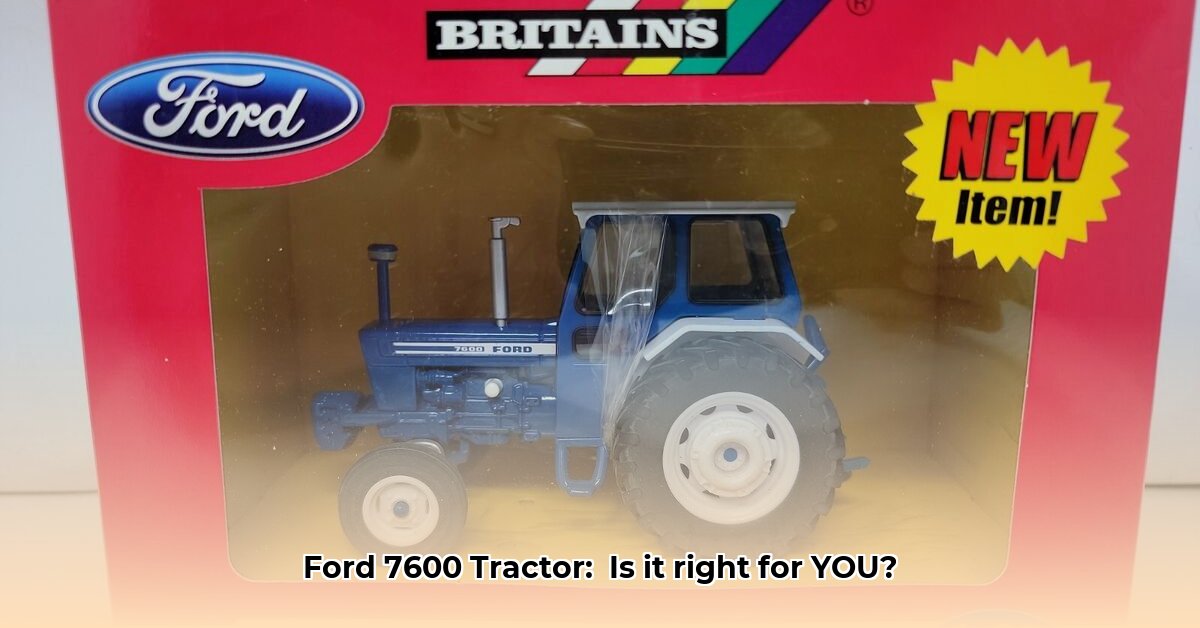
Tractor Ford 7600: A Comprehensive Guide for Buyers, Dealers, and Collectors
The Ford 7600 tractor, a stalwart of the late 1970s and early 1980s, continues to hold its own in the used market. Its robust build, powerful 96.7 gross horsepower engine (a significant power output for its time), and impressive lift capacity make it a desirable machine even today. This guide provides comprehensive advice for anyone considering buying, selling, or maintaining a used Ford 7600. We'll cover everything from pre-purchase inspections to parts sourcing and collector-specific concerns. Are you ready to navigate the world of vintage tractors? For more on Ford tractor values, check out this helpful resource: Ford tractor values.
Pre-Purchase Inspection: A Step-by-Step Guide
Buying a used Ford 7600 requires a thorough inspection. Skipping this step can lead to costly repairs down the line. Follow this checklist to avoid potential pitfalls:
Engine Assessment: Inspect for oil and coolant leaks, listen for unusual noises (knocking, rattling, squealing) indicating potential internal problems. Check belts and hoses for wear and tear. Don't forget to check the oil pressure and levels.
Transmission Examination: Test each gear for smooth shifting. Grinding, hesitation, or difficulty shifting point to transmission problems requiring potentially expensive repairs. Smooth shifting across all gears is crucial.
Hydraulic System Check: Verify the hydraulic fluid level and cleanliness. Test the lift capacity with a known weight; look for leaks around cylinders and hoses. Leaks indicate significant hydraulic system issues. This is the tractor’s lifeblood; inspect it thoroughly.
Electrical System Inspection: Test all lights, gauges, and indicators. Check the starter and alternator, critical for reliable operation. A faulty electrical system can leave you stranded.
Body and Tire Condition: Assess rust, dents, and overall body damage, signs of potential structural problems. Check tires for wear, cracks, or damage. These affect both functionality and value.
Service History Review: Obtaining a complete service history (if available) provides valuable insight into past maintenance and potential issues. The more detailed the records, the better.
Negotiating the Price: Strategies for Success
Prices for used Ford 7600 tractors vary based on condition and location. Research similar tractors on online marketplaces to establish fair market value. Factor potential repairs or upgrades into your budget. Securing pre-approved financing strengthens your negotiating position. Remember, the condition directly impacts the price.
Maintenance: Preventative Care for Long-Term Performance
Regular maintenance is key to extending the lifespan of your Ford 7600. Schedule oil changes, fluid checks (hydraulic, transmission, coolant), and filter replacements to prevent costly repairs down the road. Think of it as preventative medicine for your machinery. Preventative maintenance is far cheaper than reactive repairs.
Sourcing Parts: Locating the Necessary Components
Finding parts for a Ford 7600 requires a multi-pronged approach:
Online Marketplaces: Utilize sites specializing in agricultural equipment parts; compare prices and check reviews.
Local Dealers: While unlikely to stock many original parts, local dealers might offer alternatives or point you towards specialized suppliers.
Specialty Suppliers: Businesses specializing in vintage tractor parts are a valuable resource for hard-to-find components.
Used Parts: Consider used parts for cost savings, but always inspect carefully for wear and damage.
Salvage Yards: Don't rule out tractor salvage yards for hard-to-find components. It requires patience.
Ford 7600 Risk Assessment Matrix: Potential Problems and Mitigation
Even with thorough inspection, risks remain. This matrix highlights potential problems and mitigation strategies:
| Component | Potential Problem(s) | Mitigation Strategies | Risk Level |
|---|---|---|---|
| Engine | Leaks; low compression; worn parts. | Regular servicing; preemptive part replacement | Moderate |
| Transmission | Difficult shifting; gear slippage. | Professional inspection & potential rebuild | Moderate |
| Hydraulic System | Leaks; low pressure; pump failure. | Regular fluid checks; prompt leak repairs; pressure testing | High |
| Electrical System | Faulty wiring; alternator failure. | Thorough electrical system check; replacement parts | Low |
| Parts Availability | Difficulty finding specific parts. | Cultivate relationships with specialized parts suppliers; online searches | Moderate |
Buyer Profiles: Tailoring Your Approach
The optimal buying strategy depends on your needs:
- Farmers: Focus on mechanical condition, budget for repairs, secure financing, and compare prices to similar models.
- Dealers: Prioritize accurate condition assessment for transparent disclosure. Maintain an efficient parts sourcing and repair network.
- Collectors: Emphasize originality, prepare for longer part searches, and engage with online communities.
Conclusion: Making Informed Decisions
The Ford 7600 remains a capable and desirable tractor. By using this guide and conducting a thorough inspection, you can confidently navigate the buying process, minimize risks, and ensure your investment pays off for years to come. Remember, a well-maintained Ford 7600 can offer decades of reliable service.